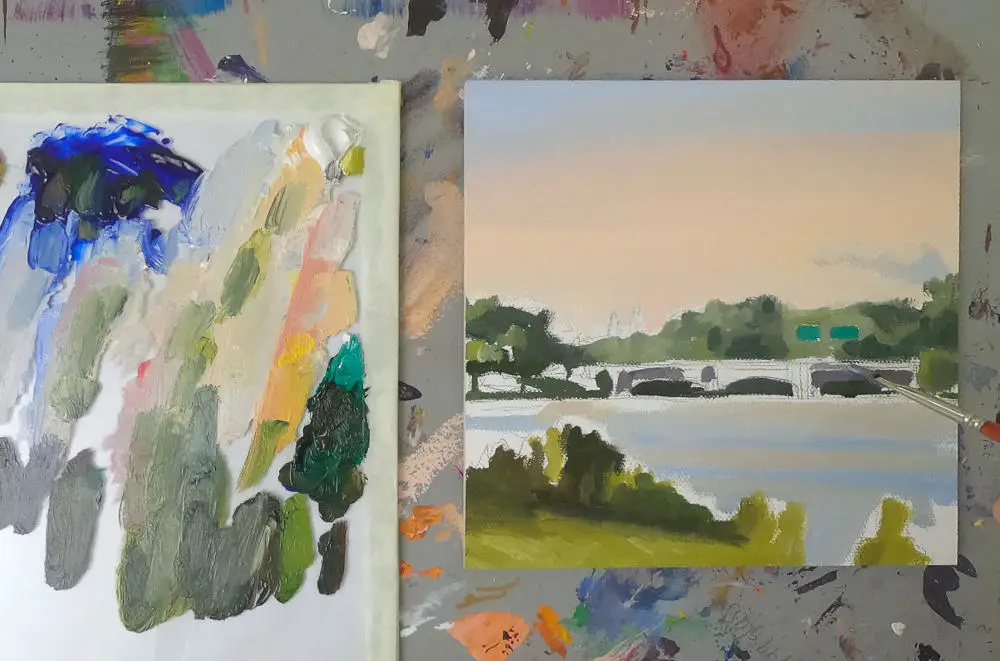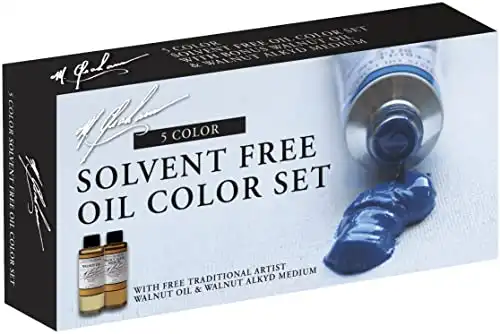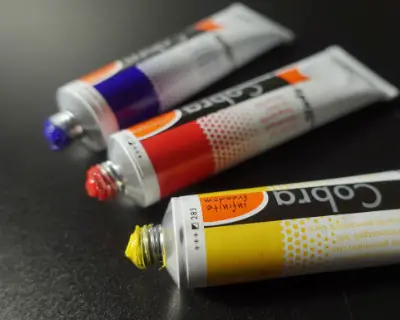If you’re like me, then you probably don’t like using paint thinner because of the smell. Not only is it unpleasant, it can also be toxic.
One solution is to use odorless paint thinner. But even odorless paint thinner requires ventilation. So maybe you’re wondering if you can just use oils without paint thinner.
Can you use oil paint without thinner? Yes, you can use oil paint straight from the tube without thinning it. It’s best to use a brand of oil paint that has a thin consistency so that you can brush it on the canvas without too much effort.
In this post, I explain my simple method for painting with oils, without using paint thinner. I use paints that don’t contain any solvents and are free from any toxic odors.
Table of Contents
What’s the Best Oil Paint for Painting Without Thinner?
I’ve tried different brands of oil paint, especially when I was in college. I find that M Graham oils work great for painting without having to add thinner.
M Graham oils flow well, straight from the tube without having to add thinner or medium.
These are the oils that I use. They're made with food grade walnut oil and no solvents. They have practically no odor, just a very faint smell of vegetable oil. It's like working in a kitchen instead of an art studio! Includes a bottle of walnut oil that you can use for cleaning brushes.
Some of the other brands of oil paints are thicker so you have to thin them down or add medium to make them flow better.
That may not be a problem if you like to use mediums or thin your oils down. But if you want you use them straight from the tube then it may be a problem.
That’s because thick paint is difficult to spread around on the canvas. You’ll have trouble filling in the texture of the canvas.
Thick paint tends to create a dry brush effect when you brush it on the surface of the canvas. You’ll find that you’ll have to scrub it on the fill in all of the nooks and crannies of the canvas.
M Graham oils seem to flow well without having to modify them with any thinner or medium. Some of the colors may be a little thicker than others, but I’ve never really found any that are too thick to use without thinning them.
As for the smell, it’s very faint and pleasant. Since the oil they use to make their paints is food grade walnut oil, I feel like I’m working in my kitchen rather than an art studio.
M Graham uses food grade walnut oil and the paint doesn’t contain any solvents.
You can describe the odor as being similar to cooking oil, or a salad dressing without the vinegar. I also thought it smells like a kitchen towel after you wash and dry it…if that makes any sense.
Anyway, the smell is faint and non toxic. And that’s coming from someone who is sensitive to smells.
I don’t even like the smell of linseed oil. It starts to irritate me after awhile. But I can work with M Graham oils for a long time without any problems.
How to Paint With Oils Without Thinner
The strategy I use for painting with oils and not thinner is to draw the image, and then fill it in with color. I don’t thin the paint since the M Graham oils already have a good consistency.
Sometimes I use a graphite pencil for sketching out my image, or maybe I’ll use a watercolor pencil.
Watercolor pencils work well because you can erase the lines by wiping the canvas with a wet rag. However, you want to make sure the canvas is completely dry before applying any oil paint.
Graphite pencil can be difficult to erase completely. You can read more about this in my post about The Best Pencil for Sketching on Canvas.
It includes a tests on a canvas where I try out graphite, watercolor pencils, and acrylic markers for sketching on canvas.
According to the manufacturer, these watercolor pencils are lightfast. I use them for sketching out ideas in my sketchbook. I like the browns and the grays for sketching on canvas.
When I’m happy with the drawing, I just mix my colors and apply them to the canvas. You can see my drawing in the on the canvas in the photo below.
It’s a simple technique and it doesn’t require any solvents at all. The paint is thin enough to brush onto the canvas.

My goal is to try to complete the painting in one layer. This isn’t always possible but that’s what I aim for because it keeps the painting process simple.
I also work rather thin too, I don’t like to build up too much texture or relief.
This is something that M Graham also recommends, which I discuss further in the section about painting with thinner.
Even when I paint with acrylics I work somewhat thin. That’s mostly because I like being able to paint over an area without having texture showing through from the previous layers.
What Is Thinner Used for in Oil Painting?
Aside from cleaning brushes, thinners often used in the first application of color. This thin layer of paint is sometimes called an underpainting.
There are a few benefits to starting with a thin underpainting. For one, thin paint dries faster than if you were to apply it in a thicker layer.
This is because the solvent evaporates quickly and the paint is dry to the touch in minutes rather than a day or so.
Blocking in the basic shapes with thin paint like this will help you to sketch out the basic composition. You can quickly work out some of the basic issues of a painting without adding too much detail.
Painting without thinner requires a different approach but you should be able to adapt with some practice.
Can You Use Thinner as an Oil Painting Medium?
You should only use paint thinner in the first layer of an oil painting. This is usually called an underpainting. Paint thinner doesn’t contain any oil or binder so you shouldn’t use it as a medium in additional layers.
“Fat over lean” is a basic oil painting principle and it refers to the oil content of the paint. It also refers to the thickness of the layers. The first layers should be thin.
The idea is that you want to have the first layers of paint drying faster than top layers. Otherwise, if you have a slow drying layer under a fast drying layer, cracks could form in the top layer.
If this doesn’t make sense, you have to think about how brittle a dry layer of oil paint is, compared to one that’s still wet.
Having a softer layer of oil paint below a layer that’s already dry, the dry layer on top won’t flex as much.
The other issue is that thinning the paint out reduces how much binder there is in the paint film.
Paint is basically a dry colorful powder and a glue that binds it together. This “glue” also makes it stick to the canvas.
In the case of oil painting, it’s the oil that’s the binder. Any time that you thin out paint, you’re also thinning out the binder.
In his book about landscape painting, Mitchell Albala states that you don’t want to thin the oil paint beyond the first layer.
This book includes many tips for painting landscapes and it also addresses the challenges of painting outdoors.
Albala states that thinner is used for the initial block in stages and warns against using thinner as a medium.
So my point is, that if you can do without that initial wash of color then you can easily adapt to painting without thinner.
Painting in Multiple Layers Without Thinner
I use the M Graham oils straight from the tube. My goal is usually to get it right with the first layer of color.
However, there are many times when you need to apply additional layers. This is because you need to fix things or you just want to add more detail.
Well, if you like to paint wet over dry you’ll have to let it dry which may take a day or more. Then, you can paint over it with another layer.
If you want to follow the fat over lean principle, you can add a very small amount of the walnut oil to your paints for the second layer.
It doesn’t have to be much, just mix in a small drop in to each pile of paint. That small amount of oil will make the second layer dry a little slower than the first.
Another point that M Graham makes on their site is that you don’t want to paint too think.
In M Graham’s post about solvent free oil painting, they say you want to paint in such a way that you retain the texture of the canvas. In other words, when you start painting thick enough to hide the canvas texture than you’re increasing the chances of it cracking.
Painting in a thin layer like this can be an advantage. For one, there’s less of a chance that the painting will crack. The painting will dry faster so you can add additional layers without having to wait too long.
Can You Add Water to Oil Paints?
Since this is a post about painting with oils without using paint thinner, you may have wonder if you can thin oil paint with water.
Can you add water to oil paint? No, oil and water do not mix so you don’t want to add water to your oil paint. Water mixable oils are the exception to this rule.
Water mixable oils are created by chemists at paint manufactures. They know what to add to the paint to make it so you can thin oil paint with water.
If you want to be able to thin oil paint with water then I suggest that you buy a brand of water mixable oils.
Water mixable oils clean up with soap and water. You can also use water to thin the paint out for the first layer of the painting. No solvents are required!
There some disagreement about whether you should use water to thin water mixable oils when you’re painting.
Some artists say that you should only use the water for cleaning your brushes. While even some manufacturers have demos where they use water to thin the paint for the first layer.
There’s no point in trying to experimenting with trying to make your own water mixable oils. Simply adding water to regular oil paint won’t work.
The cost the water mixable oils is similar to regular oils so just buy those instead of trying to make it work on your own.
Can You Thin Out Oil Paint With Vegetable Oil?
I don’t recommend adding supermarket vegetable oil to your oil paints. Vegetable oil is a general term for plant based oils such as canola, corn, palm, sunflower, and soybean oil.
So that would be like asking if all of those oils are suitable for oil painting. I’m wouldn’t make such a blanket statement like that.
There are many oils that are used to make oil paint. Linseed, walnut, and safflower are the most common.
But the vegetable oil you find in the grocery is often soybean oil. So let’s use soybean oil as an example.
I looked for information about using soybean oil in oil paints. I couldn’t find anything in The Artist’s Handbook by Ralph Mayer. However, The Painter’s Handbook by Mark David Gottsegen mentions soybean oil.
I originally discovered this book in the early 1990s and learned a lot about art materials from it. It's considered to be a classic reference guide to artists materials, mediums, tools and techniques.
He says that it dries more slowly than linseed oil and that it yellows like linseed does. So I’m not sure what the advantage of using soybean oil would be.
The only thing that I can think of is that it’s cheap. But this doesn’t make too much sense because it’s not as if you’re going through gallons of oil painting medium in your paintings.
It’s possible to use a cheap vegetable oil as a brush cleaner in the same way that you can use walnut oil to clean brushes. So maybe that’s a way that you can save money.
It’s not as quick as cleaning your brushes with paint thinner. But it does work and you don’t have to use any smelly solvents.
You can add traditional oils mediums to your paint but you want to use it sparingly. Too much oil can cause the paint to wrinkle as it dries. Another thing to consider is adding oil to the paint will make it dry slower.
Which Oils Can You Add to Oil Paint?
As a general guideline, I just use the same oil that the paint is made from.
So in the case of M Graham oils, I would add walnut oil. Most other brands of oils use linseed oil.
M Graham also states that you want you use the same type of medium throughout the entire painting to avoid uneven drying rate which cause problems. (This can be found in the same post about solvent free oil painting above).
Other manufacturers actually use different oils for their paints depending on the color. Linseed oil has a tendency to yellow as it ages so that shows up the most in white or lighter colors.
For those colors they may use safflower oil instead of linseed oil.
So that makes me think that it’s feasible to use different oils in the same painting. However, just to keep things simple, I recommend using the oil mediums that are recommended by the manufacturer.
Can I Add Olive Oil to Oil Paint?
No, you don’t want to add olive oil to paint because it’s a non hardening oil. This means that it will never dry. There aren’t any advantages to using olive oil, so it’s best to use more traditional oils such as linseed, safflower, or walnut oil.
Olive oil is also yellow in color so it’s not that it’s clearer than linseed oil or has some other advantage.
As I stated in a previous section, you don’t really use that much oil so just use oils that are made for painting.
Conclusion
Painting with oils without using any paint thinner is definitely doable. You can avoid the solvents and make your studio less hazardous.
You’ll have to adjust your technique a little, but you should be able to adapt without too much effort.
As a benefit, your paintings may actually last longer and resist cracking because you’ll be painting in thinner layers.
Also, the lack of thinner means that the paint layers should have more binder in it than if you were to add paint thinner to it. And that makes for a stronger paint film.









